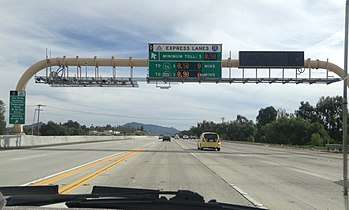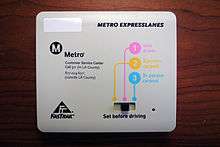High-occupancy toll lane
A high-occupancy toll lane (or HOT lane) is a type of traffic lane or roadway that is available to high-occupancy vehicles and other exempt vehicles without charge; other vehicles are required to pay a variable fee that is adjusted in response to demand. Unlike toll roads, drivers have an option to use general purpose lanes, on which a fee is not charged. Express toll lanes, which are less common, operate along similar lines, but do not exempt high-occupancy vehicles.

History
The concept developed from high-occupancy vehicle lane (HOV) systems in order to increase use of the available capacity. Most implementations are currently in the USA.
The first practical implementation was California's formerly private toll 91 Express Lanes, in Orange County, California, in 1995, followed in 1996 by Interstate 15 north of San Diego.[1][2] According to the Texas A&M Transportation Institute, as of 2012 there were 294 corridor-miles of HOT/Express lanes in operation in the United States and 163 corridor-miles under construction.[3]
The first HOT lane implementation in Canada was along the Queen Elizabeth Way (QEW) freeway in Ontario.[4] Existing high-occupancy vehicle lanes were redesignated as HOT lanes for a 16.5-kilometre (10.3 mi) stretch of the QEW between Oakville and Burlington.[5] The initial system consisted of $180 permits valid for three months, though HOT lanes with electronic tolling infrastructure were announced as part of forthcoming expansions to Ontario Highway 427.[6]
Design

Some systems are reversible, operating in one direction during the morning commute and in the reverse direction during the evening commute. The toll is typically collected using electronic toll collection systems, automatic number plate recognition, or at manned toll booths. Exempt vehicles typically include those with at least two, three or four occupants, those that use approved alternative fuels, motorcycles, transit vehicles and emergency vehicles.[7]
The fee, which is displayed prominently at entry points to the lanes, is adjusted in response to demand to regulate the traffic volume and thereby provided a guaranteed minimum traffic speed and level of service.[8][9][10][11][12]
The Los Angeles Metro ExpressLanes HOT system requires vehicles to be fitted with manually "switchable" transponders where the driver selects the number of occupants, based on which the appropriate fee is charged.[13][14] California Highway Patrol officers have in-vehicle devices which display the declared occupancy of a vehicle, which they can verify visually and cite any driver(s) with fewer occupants than declared (and tolled for).[15] The new system proved itself to be highly effective in reducing the rate of lane-use violations, with it falling to 40-50% of the violation rates of other comparable CA highways, from more than 20-25% (nearly one out of four or five) to just 10% (one in ten). Other transportation officials in California took note of this, subsequently leading to the Bay Area officials of Alameda County to adopt a similar system for the (then) planned Interstate 580.[16]
Funding and construction
Implementation of these systems can be prohibitively expensive, due to the initial construction required—particularly with regard to providing access to and from the express toll lanes at interchanges. However, the long-term benefits—the decrease in delay to able motorists and increased funding for the transportation agency—may outweigh the costs. To offset costs of construction, many transportation agencies lease public roads to a private institution. As a result, construction may be partially or fully funded by the private institution, which receives all of the income from tolling for a specified period.[17][18]
Criticism

Because HOT lanes and ETLs are often constructed within the existing road space, they are criticized as being an environmental tax or "Lexus lanes" solely beneficial to higher-income individuals, since one toll rate is charged regardless of socioeconomic status and the working poor thus suffer greater financial burden.[19] Supporters of HOT lanes counter with the fact that because HOT lanes encourage the use of public transit and ride sharing, they reduce transportation demands and provide a benefit for all.[20] However, current American public transportation is still viewed and characterized as a form of welfare, leading to paradoxical expenses as public tax dollars across the US bear high subsidies for transit services, while delivering low ridership levels, fewer service hours than other major countries with public transit systems, and longer wait times between trip destinations.[21] Furthermore, HOT lanes have demonstrated no guarantees in eliminating traffic congestion, bringing into question, their fundamental usefulness aside from raising funds for private institutions and local governments.[22]
Examples
High Occupancy Toll Lanes (HOT lanes)
- Metro ExpressLanes in California
- Virginia HOT lanes
- Interstate 405 (Washington)
- Washington State Route 167
- California State Route 237 from Mathilda Avenue to Interstate 880
- Interstate 580 in California approaching Altamont Pass
- Interstate 680 in California, various locations
- 91 Express Lanes in California
Express Toll Lanes (Express lanes)
- Northwest Corridor Express Lanes in Georgia. (No vehicles including HOV 3+ are exempt from the toll.)
- North Tarrant Express in Fort Worth, Texas. Includes Interstate 35W, Interstate 820, State Highway 183, and State Highway 121
- Interstate 10 Katy Tollway in Houston, Texas
See also
- Road space rationing
- Transportation demand management
- List of toll roads in the United States
- Feebate
References
- Dave Downey (2007-01-07). "The HOT lane hype". The North County Times. Retrieved 2008-07-15.
- Metropolitan Transportation Commission. "High-Occupancy-Vehicle (HOV) and High-Occupancy/Toll (HOT) Lanes: Frequently Asked Questions". Archived from the original on 2008-06-03. Retrieved 2008-03-01.
- Urban Land Institute (ULI) (2013). "When the Road Price Is Right – Land Use, Tolls, and Congestion Pricing" (PDF). Urban Land Institute. Retrieved 2013-04-09. See Figure 2, pp.6
- "Canada's First High Occupancy Toll Lanes Open September 15". Newsroom. Government of Ontario. September 14, 2016. Retrieved November 4, 2017.
- Lupton, Andrew (September 15, 2016). "QEW HOV lanes become HOT lanes today for single drivers". CBC News. Retrieved November 4, 2017.
- "Ontario Moving Forward On Highway 427 Expansion". Newsroom. Government of Ontario. March 3, 2016. Retrieved November 4, 2017.
High Occupancy Toll (HOT) lane infrastructure will be included in the construction work. A 15.5 km stretch of dedicated HOT lanes with electronic tolling in both directions on Highway 427, from south of Highway 409 to north of Rutherford Road, will open in 2021.
- "Exempt Vehicles". Archived from the original on 2015-01-16. Retrieved 2015-01-16.
- FAQ - VA I-495 HOT Lanes Archived 2010-11-29 at Archive.today Retrieved October 6, 2009
- Brookings Institution economic study on HOT Lanes Archived 2008-08-28 at the Wayback Machine
- MD I-95 Express Toll Lanes Archived 2012-02-24 at the Wayback Machine Retrieved October 6, 2009
- "Northern Virginia Transportation Alliance". Archived from the original on 2015-10-03.
- "Golden Gate Bridge for variable toll".
- "FAQs: FasTrak". Metro ExpressLanes. Los Angeles County Metropolitan Transportation Authority. Retrieved March 3, 2013.
- "FAQs: Driving Metro ExpressLanes". Metro ExpressLanes. Los Angeles County Metropolitan Transportation Authority. Retrieved March 3, 2013.
- Metro ExpressLanes: Rules of the Road (YouTube). Los Angeles County Metropolitan Transportation Authority. July 24, 2012. 2 minutes in.
- Richards, Gary (2014-07-11). "Bay Area carpoolers must use FasTrak in express lanes under new law". San Jose Mercury News. Retrieved 2015-07-05.
- About I-495 HOT Lanes Archived 2010-02-13 at the Wayback Machine Retrieved August 31, 2009
- "A Guide for HOT Lane Development (FHWA, 2003)". Archived from the original on 2009-09-25. Retrieved 2009-09-06.
- Malone, Kenny (2014-06-23). "Are Lexus Lanes Really Lexus Lanes?". WLRN. Retrieved 2015-04-28.
- MTC Planning - HOV/HOT Lanes Archived 2008-06-03 at the Wayback Machine Retrieved October 6, 2009
- Stromberg, Joseph (2015-08-10). "The real reason American public transportation is such a disaster". Vox. Retrieved 2018-03-25.
- Cohen, Josh (2017-11-03). "Will expansion of HOT Lanes Help Commuters?". Next City. Retrieved 2018-03-25.
External links
- "HOT for Transit? Transit's Experience of High-Occupancy Toll Lanes" (PDF). National Center for Transit Research (Center for Neighborhood Technology) at the University of South Florida. 2014. Cite journal requires
|journal=(help) - Various HOT lane articles on website dedicated to road pricing
- "Impacts of Increasing Vehicle-Occupancy Requirements on HOV/HOT Lanes" (PDF). Caltrans Traffic Operations. 2013.
- "Review of Road Pricing to Reduce Congestion" (PDF). U.S. Government Accountability Office. 2012. - includes evaluation of 21 HOT lane projects in the U.S.
- "High Occupancy Toll lane Performance Under Alternative Pricing Policies" (PDF). Transportation Research Forum. 2012. Cite journal requires
|journal=(help) - "A Lukewarm Report Card for High-Occupancy Toll Lanes". City Labs. 2012-02-02.
- "An evaluation of a high occupancy toll (HOT) lane demonstrator project in San Diego". Association for European Transport. 1998. Cite journal requires
|journal=(help)